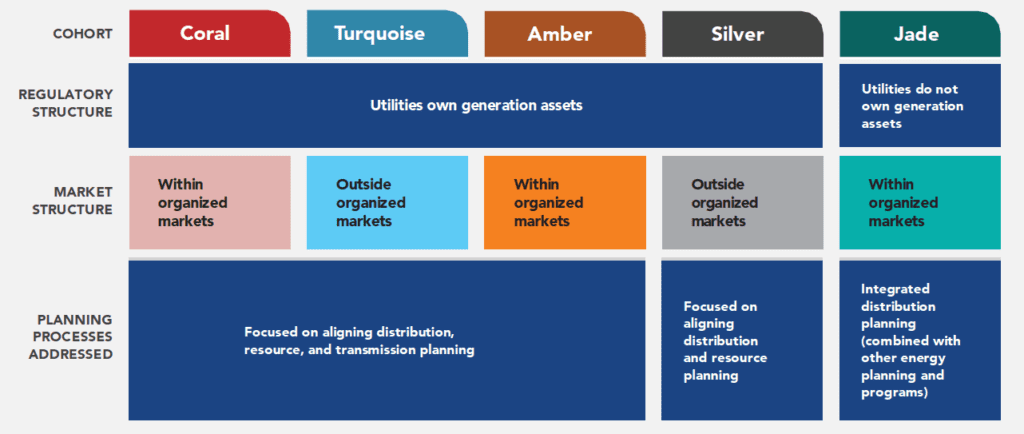To identify key innovations to state’s electricity planning, the National Association of Regulatory Utility Commissioners (NARUC) and the National Association of State Energy Officials (NASEO) formed the Task Force on Comprehensive Electricity Planning. The Task Force has now released a Blueprint for State Action, five Roadmaps for Comprehensive Electricity Planning, an online library, and additional resources (click here for a factsheet).
We asked Task Force co-chair Jeffrey Ackermann, former chairman of the Colorado PUC, to give our community some context. Here are his comments.
While every state, and region, tends to think its circumstances are unique, they all share the challenge of keeping up with a changing electric industry. Nowhere is that challenge more acutely felt than in system planning. That was the conclusion of state energy officials, speaking through their national association (NASEO) and state utility regulators, speaking through NARUC.
In 2019, NASEO and NARUC expressed a shared concern, from their respective policy and regulatory perspectives: electric system planning is under unsustainable stress. Energy technologies, the increasingly clear economic benefits of incorporating those technologies and rapidly evolving energy policies have all been applying pressure to traditional electric system planning.
Electric system planning is under unsustainable stress. At the same time, electric utility regulatory oversight is under increasing pressure to incorporate new and myriad criteria.
At the same time, electric utility regulatory oversight is under increasing pressure to incorporate new and myriad criteria into public-interest decision-making. This pressure is coming from expanding consumer expectations, unprecedented challenges to system reliability & resiliency and the growing imperative to address climate impacts head-on.
With financial and project support from US DOE, the NASEO-NARUC Task Force on Comprehensive Electric System Planning was born. Numerous states and territories applied to participate. Ultimately 15 were selected, with each committing to ongoing, active participation from a regulatory commissioner, energy official and staff.
Five cohorts with Roadmaps, Plans and Resources
The diversity of market operations, utility structures and regulatory practices provided a framework for developing five cohorts, with each cohort containing states/territories that shared common characteristics.

One key cohort characteristic is whether the participating entities operate within an organized electric market. The second characteristic is whether the jurisdiction’s utilities own generation assets, for it represents a particular regulatory structure. Then the participating states/territories were grouped according their respective planning objectives:
- Aligning distribution, resource, and transmission planning
- Aligning distribution and resource planning
- Integrated distribution planning (combined with other energy planning and programs)
So, two-plus years later, the Task Force has delivered. The five cohorts have created “Roadmaps” that outline an idealized approach to addressing the respective planning objectives. Moving from the ideal to the actual, the participating states further established “Blueprints for State Action.” These documents not only outline discrete, state-specific actions toward the planning ideals, these represent action steps that the other 35+ states and territories can readily replicate.
Thus, if you’re working in a state or territory whose electric system planning shows symptoms of unsustainable stress, the results of the Task Force are ready for your utilization.
- First, find yourself among the five distinct circumstances reflected in the cohorts, both in terms of market/regulatory structures matching your situation and your particular planning objectives. Note: determining your planning objectives requires a degree of collective self-reflection. What trends (technological, economic, political, etc.) are most readily applying pressure? What gaps in current planning practices are most evident?
- Then, begin exploring the corresponding Roadmap, Action Plans and supporting resources. The potential to overhaul your planning practices, and thereby further your state-specific objectives can be achieved by exploring and applying the Task Force resources at your disposal.
So go forth. For there is much to gain: accelerated clean energy implementation; greater system resiliency; and substantial hedges against incurring unnecessary costs to be borne by electricity customers.
If you wish to explore this further, you’re welcome to contact me at jeffack23@gmail.com .
Jeff Ackermann
Former chairman, CO PUC
Co-Chair, NARUC-NASEO Task Force on Comprehensive Electric System Planning

